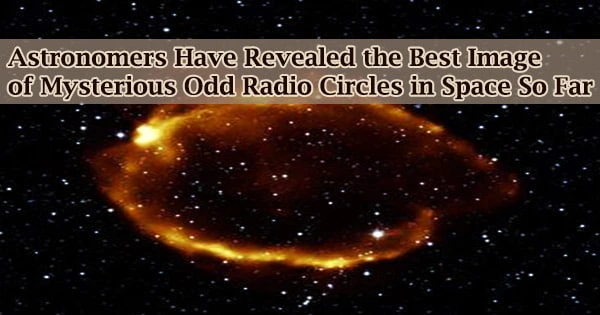Odd radio circles, or ORCs, are the newest mystery objects in astronomy, and a multinational team of scientists utilizing the world’s most powerful radio telescopes has brought into clear focus them.
Odd radio circles were first discovered in 2020 by the ASKAP radio telescope, which is owned and run by Australia’s national science organization, the CSIRO. Theoretical explanations varied from cosmic shockwaves to wormhole throats.
Researchers now have more information thanks to a new detailed image acquired by the South African Radio Astronomy Observatory’s MeerKAT radio telescope and published today in Monthly Notices of the Royal Astronomical Society.
There are now three leading theories to explain what causes ORCs:
- They could be the remains of a catastrophic explosion in the galaxy’s core, such as the merging of two supermassive black holes;
- They could be enormous jets of energetic particles ejected from the galaxy’s core; or
- They could be the outcome of a starburst ‘termination shock’ caused by the galaxy’s star creation.
ORCs have only been discovered using radio telescopes so far, with no evidence of them being found using optical, infrared, or X-ray telescopes.
Dr. Jordan Collier of the Inter-University Institute for Data-Intensive Astronomy, who produced the image using MeerKAT data, said that researchers will learn more about these strange radio circles if they continue to watch them.
“People often want to explain their observations and show that it aligns with our best knowledge. To me, it’s much more exciting to discover something new, that defies our current understanding,” Dr. Collier said.
Nearly all astronomy projects are made better by international collaboration both with the teams of people involved and the technology available. ASKAP and MeerKAT are both precursors to the international SKA project. Our developing understanding of odd radio circles is enabled by these complementary telescopes working together.
Professor Elaine Sadler,
The rings are massive, measuring a million light years wide, or 16 times the size of our own galaxy. Despite this, strange radio circles are difficult to spot.
Only about five radio circles have ever been discovered in space, according to Professor Ray Norris of Western Sydney University and CSIRO, one of the paper’s authors.
“We know ORCs are rings of faint radio emissions surrounding a galaxy with a highly active black hole at its centre, but we don’t yet know what causes them, or why they are so rare,” Professor Norris said.
Professor Elaine Sadler, Chief Scientist of the CSIRO’s Australia Telescope National Facility, which includes ASKAP, noted that for the time being, ASKAP and MeerKAT are collaborating to quickly discover and describe these objects.
“Nearly all astronomy projects are made better by international collaboration both with the teams of people involved and the technology available,” Professor Sadler said.
“ASKAP and MeerKAT are both precursors to the international SKA project. Our developing understanding of odd radio circles is enabled by these complementary telescopes working together.”
Scientists will require access to even more sensitive radio telescopes, such as those of the SKA Observatory, which is supported by more than a dozen countries, including the United Kingdom, Australia, South Africa, France, Canada, China, and India, to truly understand strange radio circles.
“No doubt the SKA telescopes, once built, will find many more ORCs and be able to tell us more about the lifecycle of galaxies,” Professor Norris said.
“Until the SKA becomes operational, ASKAP and MeerKAT are set to revolutionise our understanding of the Universe faster than ever before.”
ASKAP is located on Wajarri Yamatji country in Western Australia, and MeerKAT is located in the Northern Cape province of South Africa.





